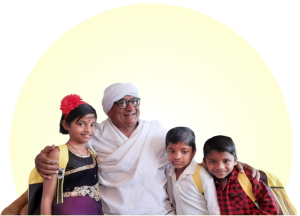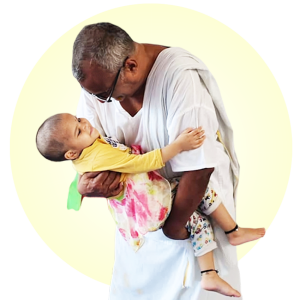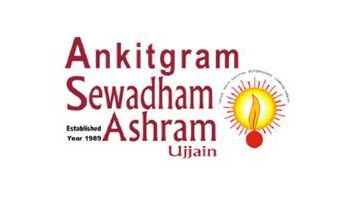
Sudhir Bhai Goyal 'Bhaiji'
Sudhir Bhai Goyal, affectionately known as "Bhaiji," was born into a modest, disadvantaged family. During his childhood, witnessing the struggles of his mentally ill uncle, his disabled grandmother, a friend’s brother, a freedom fighter forced to beg due to circumstances, he resolved to dedicate his life to helping such individuals. He was deeply inspired by the teachings of Mahaveer Swami, Maharaja Agrasen, Swami Vivekananda, Mahatma Gandhi, and Vinoba Bhave. Additionally, his parents’ challenging yet sensitive lives influenced him profoundly. His maternal grandparents and uncle Ratnakar Bhartiya, a BBC London correspondent and freedom fighter, also provided direct guidance. He set his life goal as "Manav Sewa, Madhav Sewa" (Service to humanity is service to God). Since 1970, Bhaiji has been associated with RSS as Bal Swayam Sewak, Mahakal Shakha, here the seed of rashtra sewa was implanted in him. Later drawing inspiration from leaders like Shri Nanaji Deshmukh, Shri K S Sudarshan, Shri Bhaiyaji Joshi, Dr H R Nagendra, Shri V S Kokje, Shri Parag Abhayankar, Shri Gunwant Singh Ji, Shri Sundar Laxmanji, and recently Advocate Alok Kumar visited, all who have been instrumental in shaping his journey. With over 54 years of dedicated service, he has made significant contributions in various fields, particularly in supporting differently-abled individuals. The ashram's focus has been on empowering differently-abled kids, who are trained in advanced yoga and malkhamb. These children have showcased their talents on numerous platforms, including the United Consciousness International Program held in Ujjain, where their performances garnered praise from national and international figures. They have also been praised figures like yoga Guruji Dr. H R Nagendra. Bhaiji is now working diligently to train these differently-abled kids for the Paralympics, with the goal of representing India on the global stage and winning for the country.
 In addition to his work with disabled children, Bhaiji has also made substantial contributions to environmental conservation, particularly in the cleaning and revival of the Kshipra River. His 2004-2005 river cleaning drive left a lasting impact on the community, significantly contributing to the river’s restoration. Furthermore, Bhaiji played a crucial role in deepening the Gambhir Dam in both 1989 and again in 2023-2024, recognizing its importance as the primary water source for Ujjain, which was seen and praised by the ex-CM Shri Sivraj Singh Chauhan and current CM Dr. Mohan Yadav. Jal Yoddha Padma Shri Umashankar Pandey also saw the work done towards this water conservation effort and appreciated it, then he started off the mission of ‘khet par medh aur medh par ped’. This effort not only ensured a reliable water supply for the population but also helped raise groundwater levels in the region. His work in water conservation has been widely recognized, with praise from figures like Dr. Jatiya, Dr. Mamu N Kulkarni, Dr. S N Subbarao, as well as respected journalists, politicians, businessmen, and social workers. Different community leaders, different society heads and works, college youth and many others also contributed on appeal from Bhaiji. He has also been visited and praised by Smt Anantiben Patel (Governor of UP), Shri Mangubhai Patel (Governor of MP), Shri Thawar Chand Gehlot (Governor of Karnataka), Shri Mohd Arif Khan (Governor of Kerala), Prof. Kaptan Singh Solanki (ex-Governor), Shri Nitin Gadkari and Smt Sushma Swaraj. Bhaiji’s multifaceted contributions, from empowering differently-abled youth to advocating for environmental sustainability, reflect his unwavering commitment to social service and community well-being. His work was acknowledge by many prestigious awards, some of which are: 1st award by Bhaiyadi Daani Sewa Sansthan; Best Social Organisation Award (to Bhaiji and his establishment) by Government of India; Maharishi Dadichi Award by Government of MP (for work done for specially abled individuals), Mahaveer Award by Mahaveer Foundation, Swami Rama Humanitarian Award by former PM Manmohan Singh, Saraswat Samman by Honorable ex-President Shri Ram Nath Kovind.
In addition to his work with disabled children, Bhaiji has also made substantial contributions to environmental conservation, particularly in the cleaning and revival of the Kshipra River. His 2004-2005 river cleaning drive left a lasting impact on the community, significantly contributing to the river’s restoration. Furthermore, Bhaiji played a crucial role in deepening the Gambhir Dam in both 1989 and again in 2023-2024, recognizing its importance as the primary water source for Ujjain, which was seen and praised by the ex-CM Shri Sivraj Singh Chauhan and current CM Dr. Mohan Yadav. Jal Yoddha Padma Shri Umashankar Pandey also saw the work done towards this water conservation effort and appreciated it, then he started off the mission of ‘khet par medh aur medh par ped’. This effort not only ensured a reliable water supply for the population but also helped raise groundwater levels in the region. His work in water conservation has been widely recognized, with praise from figures like Dr. Jatiya, Dr. Mamu N Kulkarni, Dr. S N Subbarao, as well as respected journalists, politicians, businessmen, and social workers. Different community leaders, different society heads and works, college youth and many others also contributed on appeal from Bhaiji. He has also been visited and praised by Smt Anantiben Patel (Governor of UP), Shri Mangubhai Patel (Governor of MP), Shri Thawar Chand Gehlot (Governor of Karnataka), Shri Mohd Arif Khan (Governor of Kerala), Prof. Kaptan Singh Solanki (ex-Governor), Shri Nitin Gadkari and Smt Sushma Swaraj. Bhaiji’s multifaceted contributions, from empowering differently-abled youth to advocating for environmental sustainability, reflect his unwavering commitment to social service and community well-being. His work was acknowledge by many prestigious awards, some of which are: 1st award by Bhaiyadi Daani Sewa Sansthan; Best Social Organisation Award (to Bhaiji and his establishment) by Government of India; Maharishi Dadichi Award by Government of MP (for work done for specially abled individuals), Mahaveer Award by Mahaveer Foundation, Swami Rama Humanitarian Award by former PM Manmohan Singh, Saraswat Samman by Honorable ex-President Shri Ram Nath Kovind.
 Sudhir Bhai, a science graduate, demonstrated leadership qualities from a young age. Hailing from Rajasthan through his paternal lineage, he was raised by Gujarati families, which further instilled in him the values of service. At just 7 years old, he frequently visited the Visarjan Ashram in Indore, founded by Vinoba Bhave, where he met freedom fighter Babu Moolchand Agrawal, whose presence inspired him.
Sudhir Bhai, a science graduate, demonstrated leadership qualities from a young age. Hailing from Rajasthan through his paternal lineage, he was raised by Gujarati families, which further instilled in him the values of service. At just 7 years old, he frequently visited the Visarjan Ashram in Indore, founded by Vinoba Bhave, where he met freedom fighter Babu Moolchand Agrawal, whose presence inspired him.
In 1970, at the tender age of 13, Sudhir Bhai established a village school in Ajnoti through the Vivekanand Bal Vikas Samiti, which he founded. Students had to wade through a stream to attend the school. To fund the school, Sudhir Bhai often took money from his father’s shop without informing him. His father punished him when he came to know about the stealing, but when he learned of the reason, he began giving him Rs.2 daily to support his cause. His mother, Satyavati Devi, also supported his efforts, marking the beginning of his social work journey, with his parents being his greatest supporters.
He adopted the five principles of service: Sewa (Service), Shiksha (Education), Swasthya (Health), Swavlamban (Self-reliance), and Sadbhav (Harmony) as his life’s ideals. In 1972, the District Collector, Shri I.S. Rao, helped advance his work, and subsequently, other district collectors, such as Shri V.P.Singh, Shri A.K.Vijayvargiya, Shri Nanhe Singh, Shri Ajit Raijada, Shri Pradeep Bhargawa, Shri Prakash Chandra, Shri Sudarshan Synghal, Shri Rakesh Bansal, Shri Vivek Dhand, Shri G.P.Tiwari, Shri R.C.Sinha, Shri Seva Ram, Shri K.P.Singh, Shri Vinod Semwal, Shri C.P.Arora, Shri Bhupal Singh, Dr.Rajesh Rajora, Shri Vivek Aggarwal, Shri Neeraj Mandloi, Shri Shiv Shekhar Shukla, Shri Ajatshatru Shrivastava, Smt. M. Geetha, Shri B.M. Sharma, Shri Kavindra Kiyawat, Shri Sanket Bhondave, Shri Manish Singh, Shri Shashank Mishra and Neeraj Singh, alongside IAS officers like Anshul Gupta, saw the work done by Bhaiji and are providing continued support to him. Post the establishment of the Commissionaire, several other officers, including IAS Shri PGY Mudliyar, Shri Santosh Kumar Sharma, Shri Omprakash Mehra, Shri Sharad Chandra Behar, Shri Ravindra Sharma, Shri Raghunath Prasad, Shri Vinod Kumar Dhal, Shri Ramesh Saxena, Shri Nanhe Singh, Shri Maan Dahima, Shri Mohan Gupt, Shri Dr. P. Raghavan, Miss S. Raavla, Shri Jaideep Govind, Shri S.K.Vashistha, Shri T. Dharma Rao, Shri Arun Kumar Pandey, Shri K. C. Gupta, Shri Shiv Shekhar Shukla, Shri Ravindra Pastor, Shri Anand Sharma and others, also lent their support and encouragement, maintaining lasting relationships that continue to this day. Over 100s of IAS, IPS, IRS, and IFS officers have closely associated with and been influenced by Bhaiji’s work, there is a never-ending list of these respectable supporting officers.
Sudhir Bhai extended his services to remote rural and tribal areas, including Jhabua, Dewas, Alirajpur, and other districts in the Indore and Ujjain regions, as well as in slums. He worked in disaster-affected areas, spending 13 months in Kutch, Bhuj, for earthquake relief, a project appreciated by now the Honourable Prime Minister of India, then Gujarat Chief Minister Shri Narendra Modi. He also contributed financially to relief efforts in Kerala during a landslide recently through the Honourable Governor Shri Mohd Arif Khan and also provided shelter at the ashram to victims of the Latur earthquake.
Bhaiji’s 54-year journey of service has been an incredible story of struggle and perseverance, demonstrating unwavering dedication to his mission. His path was fraught with challenges that could have made him give up, but he remained committed to his vision with a positive approach. He never saw his adversaries as enemies but rather honored them as “kalyan mitra” (friends of welfare). In 1975, he survived a landslide in Badrinath, which he considers his second life. Initially aspiring to become a doctor, Sudhir Bhai gained admission to Medical College in Vardha through Dr. Sushila Nayaar. However, after a meeting with Acharya Vinoba Bhave at Pavnar in 1976, Shri Vinoba Bhave advised him to continue his current work and become a “doctor of service,” emphasizing that India’s soul resides in its villages.
 In 1979, Sudhir Bhai lost sight in his left eye while rescuing children during a trip to Pachmarhi. Despite personal tragedies, including the loss of his only son in 1991, the murder of his sister in 1992, and the untimely death of his father in 1993, Sudhir Bhai remained resolute in his mission of selfless service. Throughout these struggles, his dedication to his mission of “Manav Sewa, Madhav Sewa” never wavered, even as these events took place after the establishment of the ashram. Even his family faced criticism due to which they lost home at times and he had to motivate them again and they also faced financial challenges.
In 1979, Sudhir Bhai lost sight in his left eye while rescuing children during a trip to Pachmarhi. Despite personal tragedies, including the loss of his only son in 1991, the murder of his sister in 1992, and the untimely death of his father in 1993, Sudhir Bhai remained resolute in his mission of selfless service. Throughout these struggles, his dedication to his mission of “Manav Sewa, Madhav Sewa” never wavered, even as these events took place after the establishment of the ashram. Even his family faced criticism due to which they lost home at times and he had to motivate them again and they also faced financial challenges.
He married Kanta Devi in 1983, from the Potdaar group of industries in Indore. After marriage, their thoughts didn’t align for many years, but eventually, Kanta Devi connected herself with his work. Today, she, along with their two daughters, lives in Ankitgram and is fully supportive of the cause. Inspired by his childhood experiences, he wanted to harness the talent and experience of senior citizens for the benefit of society. To achieve this, in 1986, he founded the Ujjaini Vasishta Nagrik Sangathan and began setting up senior citizen establishments in different villages.
One day, while visiting the leprosy settlement in Hamu Khedi, he was deeply saddened by the horrific conditions of the leprosy patients. There was no electricity or water, and the filth was so severe that wild rats were gnawing on their insensitive body parts. In Ujjain, they were not allowed to be cremated in the regular cremation grounds. The children of these leprosy patients were not allowed to attend the village school. Health services were almost non-existent, and doctors refused to visit the area. The village hospital housed animals, and their fodder was kept inside, with no toilets available. A missionary was the only one providing support to the leprosy patients.
During one of his visits, he encountered a middle-aged man lying face down in a hut, suffering from a bed sore with thousands of worms crawling inside. The stench made it unbearable to stand nearby. With the help of Heri Bai, he tied the man to a two-wheeler and took him to the district hospital, where the conditions were equally poor, and filth covered the leprosy ward. He then brought the man to his office at Durga Plaza, where he kept him in the garage, learned to administer penicillin injections, bathed him, dressed his wounds, and took care of him daily. Despite opposition from the people around him, he did not give up.

He established a leprosy service center, fought many battles for these patients, and ensured they received all the necessary life-supporting facilities from the government. Dr. Jatiya used funds from the MP’s quota to build a hall for the leprosy center, and the municipal corporation provided many facilities. He ensured that the children of the leprosy patients received an education, and the women were taught, many of whom now work in various government and non-government services.
His efforts in leprosy service were recognized and appreciated by senior IAS officers like IS Rao, DG Bhave, RK Shrivastav, JP Vyas, Ujjain’s commissioners, collectors, Dada Saheb Phalke Award winner A. Nageshwar Rao, Didi Nirmala Deshpande, Dr. S.N. Subbarao, and even chief ministers. On March 13, 1987, Mother Teresa visited his leprosy program and inaugurated the healthcare center, with Kanta Ji and their son Ankit by his side. The following year, in 1988, Baba Amte saw the work done for leprosy patients, praised it, and provided guidance.
After meeting both Mother Teresa and Baba Amte, he took an oath to establish an ashram for those suffering Ultimately, in 1989, Bhaiji decided to close his business, leave behind his luxurious and comfortable life, and nurture the dream of establishing an ashram. Today, the family resides with minimal facilities. The very idea of establishing the ashram disturbed the entire family. Despite the opposition from his family, Bhaiji remained resolute in his determination and began searching for land for the ashram. The current site of Gambhir Bandh AnkitGram Sewadham Ashram was established in 1989, and it was his dream project dedicated to “Manav Sewa, Madhav Sewa” (Service to Humanity, Service to God). At that time, the land was barren, uneven, with no road, electricity, or water, and inhabited by wild animals, but he chose it. His choice of barren land was rooted in the principle of “Shram Sadhna” — the belief that through hard work and dedication, he could transform desolate land into a thriving sanctuary.
The ashram began with a small mud hut, and its first resident was Gulab Maa, a 95-year-old woman from Bharatpur, Rajasthan, who was found bedridden, in a dying state, with bedsores infested with countless worms. She was lying in such filthy and foul-smelling conditions near Sant Kishori Ji’s ashram in Ujjain that it was impossible to stand near her for even a second. She was brought to the ashram through the support of Sant Shri. During the time spent caring for leprosy patient Narayan and Gulab Maa, Bhaiji saw a divine smile on their faces, which felt like a glimpse of God.
 From then on, he started bringing homeless, destitute, and dying people from the streets, hospitals, bus and railway stations, and other places. The local villagers caused many difficulties, and even his family didn’t support him. But he continued to advance in his mission. Over 9,000 people have been housed in the ashram, including children, the elderly, disabled, terminally ill, bedridden, and mentally disturbed individuals. The ashram also supports those suffering from serious illnesses such as cancer, HIV, and TB, as well as exploited and mentally ill pregnant women and their newborns. These individuals are rescued from roads, hospitals, bus stations, railway stations, temples, riverbanks, and similar locations.
From then on, he started bringing homeless, destitute, and dying people from the streets, hospitals, bus and railway stations, and other places. The local villagers caused many difficulties, and even his family didn’t support him. But he continued to advance in his mission. Over 9,000 people have been housed in the ashram, including children, the elderly, disabled, terminally ill, bedridden, and mentally disturbed individuals. The ashram also supports those suffering from serious illnesses such as cancer, HIV, and TB, as well as exploited and mentally ill pregnant women and their newborns. These individuals are rescued from roads, hospitals, bus stations, railway stations, temples, riverbanks, and similar locations.
Admissions to the ashram are facilitated through recommendations from various government bodies such as the Department of Women and Child Welfare, the Department of Social Justice, the Judiciary, the Child Welfare Committee, as well as Members of Parliament, Members of the Legislative Assembly, District Collectors, the Police Department, government hospitals, mental health institutions, and other agencies. Presently, the ashram supports over 850 beneficiaries, plus 150 leprosy patients, bringing the total to over 1,000 individuals who regularly benefit from its services. These people come from all corners of India.
During the COVID-19 pandemic, the Women and Child Welfare Department openeda quarantine center for children at the ashram, and the ashram gave admission to about 179 individuals during the pandemic. The “Feed the Hungry” initiative has provided meals to over 525,000 hungry and deprived individuals during the pandemic and continues to serve between 100-300 people daily outside the ashram, till date.
Sudhir Bhai has facilitated the weddings of over 100 girls, beginning with the wedding of a girl from Padma Shri Shalini Tai Moghe’s ashram. On 12 March 2020, at Bhaiji’s initiative, then District Collector Sanket Bhondwe, arranged the marriages of 122 differently-abled couples, and Bhaiji along with his wife Kanta Ji, performed the “kanyadaan” for 29 of them, setting a world record. This process of marrying differently abled individuals is still continued.
Running the ashram was a monumental challenge, with Sudhir Bhai and Kanta Ji investing all their personal resources into it by selling of their property and other owned assets. In 2004, the ashram faced significant struggles, and during a meeting with Jainacharya Mahapragya Ji in Ratlam on April 24, 2004, Bhaiji took the oth of ‘Anna Tyaag’ for the upliftment of the ashram and its beneficiaries. This vow was lifted after 12 years when, in 2016, Lok Sabha Speaker Smt. Sumitra Mahajan honored him during a major event at the ashram and broke his oath by ‘Anna Prashya’. Development activities in the ashram accelerated, and beneficiaries continued to increase from all over the country day by day.
In addition to his personal efforts, over 500 individuals have regained eyesight through eye donations, more than 250 eye and health camps have benefited over 200,000 people, and the ashram has facilitated over 178 body donations, helping thousands of future doctors. More than 4,000 individuals have been successfully rehabilitated into mainstream society.
Bhaiji’s 2004-2005 cleaning drive for the Kshipra River had a lasting impact, and his involvement in deepening the Gambhir Dam in 1989 and again in 2023-2024 significantly contributed to Ujjain’s water supply.
After losing his son in 1992, Bhaiji began greening the ashram and its surroundings, planting over 125,000 trees, including 11,000 in 2024 alone, covering a 2-kilometer radius. Today, the ashram’s atmosphere is thriving.
Sewadham Ashram, possibly the first in India to selflessly contribute to eye and body donations, has also made significant efforts in animal welfare. The ashram’s Gaushala shelters over 100 non-productive cows rescued from slaughterhouses, providing them with a safe, caring environment.
Impact
![]() Ashram’s impact extends beyond providing basic needs; it restores dignity and offers new beginnings to those who had been cast aside by society. Through compassionate care, holistic rehabilitation, and a commitment to human welfare, Ashram stands as a beacon of hope and transformation for India’s most vulnerable populations.
Ashram’s impact extends beyond providing basic needs; it restores dignity and offers new beginnings to those who had been cast aside by society. Through compassionate care, holistic rehabilitation, and a commitment to human welfare, Ashram stands as a beacon of hope and transformation for India’s most vulnerable populations.
Through the five principles of service: Sewa (Service), Shiksha (Education), Swasthya (Health), Swavlamban (Self-reliance), and Sadbhav (Harmony). The education system has improved in the rural and tribal areas and more children are getting educated. The rate of literacy has also increased among women in the region. Health care services and awareness has been impacted for good. The mutual relation and problem solving within the society initiative has also impacted the daily life.
Plantation drive has influenced the people as they have started getting connected to the nature and greenery again and have started actively taking part in plantation drive which will have a long term impact on the environment.
Society has started accepting differently-abled women as their spouse which is a result of the work done by the ashram. The change in this way society has been looking at the differently-abled women.
Tehsil Ghatiya has seen drastic change by the family planning drive with the help from family planning association 40 years back. It has been ranked top for many years.
Awareness about condoms in association with Dr. Manu N Kulkarni, UNICEF chief in MP.
Seminars on national and international levels by and for the youth, for building an addiction-less and corruption-less India.
Considering and promoting ashram as a family and installing the values of family in the residents of the ashram, by which they live in harmony and have respect for the women and elders, are learning to be independent and leading a life with dignity. The addicted have changed.
Worked for mentally challenged people has a huge impact, people who were not ready to understand the basic social behaviour like respecting or wearing clothes and such civic sense have been handled with care and love. Now they have been successfully rehabilitated in the main stream society. This has been recognized by Nimhans Banglore and appreciated by them.
Children at ashram are being given a new light and vision by promoting yoga, sports, training, cultural programs, outings, etc. They have excelled in these and have performed at MP’s Governors house, Goa, Mumbai, Delhi, etc.
Contribution
![]() The current site of AnkitGram Sewadham Ashram was established in 1989, and it was his dream project dedicated to “Manav Sewa, Madhav Sewa”. At that time, the land was barren, uneven, with no road, electricity, or water, and inhabited by wild animals, but he chose it. His choice of barren land was rooted in the principle of “Shram Sadhna” — the belief that through hard work and dedication, he could transform desolate land into a thriving sanctuary.
The current site of AnkitGram Sewadham Ashram was established in 1989, and it was his dream project dedicated to “Manav Sewa, Madhav Sewa”. At that time, the land was barren, uneven, with no road, electricity, or water, and inhabited by wild animals, but he chose it. His choice of barren land was rooted in the principle of “Shram Sadhna” — the belief that through hard work and dedication, he could transform desolate land into a thriving sanctuary.
Any resident who is given admission in the ashram is considered as a representative of god and his first sewa like bathing and cleaning is done by Bhaiji himself, a way of serving god.
His 2004-2005 cleaning drive for the Kshipra River left a lasting impact on the community and contributed significantly to the river’s revival. He was also involved in deepening the Gambhir Dam in both 1989 and again in 2023-2024, a vital project as the dam serves as the primary water source for Ujjain’s population.
More than 9,000 have been supported, with over 500 gaining eyesight through eye donations, which is as per the wish of residents. Over 250 eye and health camps have benefitted over 200,000. Medical institutions have received over 178 body donations, about 4,000 have been successfully rehabilitated into mainstream society. As ashram has residents from all religions, last rites are conducted as per their religious beliefs. Bhaji has also selected his cremation place in the ashram ‘Satyansh Sewa Bhumi’.
Sudhir Bhai’s efforts have impacted more than 700,000 urban, rural, and tribal people. His team also worked in remote tribal areas, rescuing many mentally challenged people who were shackled. After recovery, these individuals were rehabilitated at ashram, with some still living with us.
Organizing Varsha Mangal Mahotsav since 1992, in the memory of Late Master Ankit. Its main goal to promote planation drive. Under this drive planted over 1,25,000 trees, from which 11,000 trees have been planted in the current year only. It has changed the landscape of the region.
Established a leprosy welfare centre, fought many battles for these patients, and ensured they received all the necessary life-supporting facilities from the government. Dr. Jatiya used funds from the MP’s to build a hall for the community center, and the municipal corporation provided many facilities. Bhaiji ensured that the children of the leprosy patients received education, and the women were taught, many of whom now work in various government and non-government services. And the support is continuing since 1986 in a regular way.

